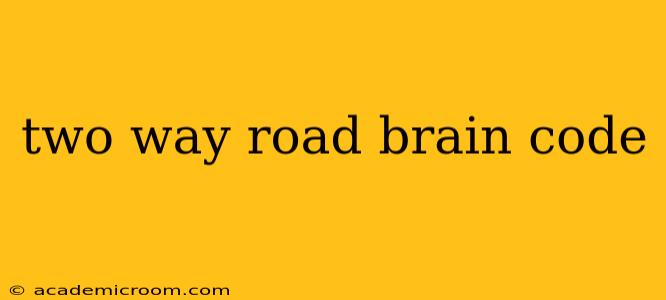The human brain, a marvel of biological engineering, operates on a complex system of interconnected pathways, often described metaphorically as a "two-way road." This analogy highlights the bidirectional nature of neural communication, where information flows not only from one region to another but also back again, creating a dynamic and intricate network. Understanding this "two-way road" is crucial to comprehending how we learn, remember, and process information.
What is meant by "two-way road" in the context of brain code?
The "two-way road" refers to the bidirectional communication between neurons, the fundamental building blocks of the brain. Unlike a one-way street, neural pathways allow for constant feedback and reciprocal interactions. A signal originating in one brain area doesn't simply travel to another; it also triggers responses and adjustments in the originating area based on the recipient area's processing. This constant feedback loop is essential for refining neural pathways and learning new information.
How do these two-way pathways influence learning and memory?
Learning involves strengthening or weakening connections between neurons. This strengthening, known as long-term potentiation (LTP), occurs when neurons repeatedly fire together. This process is inherently bidirectional. When a new experience activates a neural pathway, the "two-way road" allows feedback signals to modify the strength of synapses (connections) along the route, strengthening the memory trace. Conversely, weakening of connections, or long-term depression (LTD), allows for pruning of unnecessary or less-frequently used pathways, optimizing brain function.
What are some examples of two-way communication in the brain?
Consider the process of reading. Visual information from the eyes travels to the visual cortex, but then that information is relayed to areas involved in language processing (like Wernicke's area) for comprehension. Simultaneously, feedback from these language areas guides the visual processing, helping you focus on relevant visual cues and improve reading comprehension. This constant interplay is the "two-way road" in action.
Another compelling example is motor control. When you reach for a cup, your brain sends signals to your muscles to initiate the movement (efferent signals). However, your brain also receives feedback from sensory receptors in your muscles and joints about the position and movement of your hand (afferent signals). This feedback continually adjusts the motor commands, ensuring smooth and accurate movement. Without this feedback loop, precise movements would be impossible.
How does this "two-way road" relate to neural plasticity?
The brain's remarkable ability to adapt and change throughout life, known as neural plasticity, relies heavily on this bidirectional communication. New experiences and learning reshape neural pathways by altering the strength of connections. The feedback mechanisms inherent in the "two-way road" allow the brain to fine-tune these pathways, maximizing efficiency and adaptability.
What are the implications of understanding the "two-way road" brain code?
Understanding the bidirectional nature of neural communication has profound implications for numerous fields:
- Neuroscience Research: It guides research into learning, memory, and neurological disorders.
- Neurorehabilitation: It informs therapies for stroke recovery and other neurological impairments, focusing on retraining neural pathways.
- Artificial Intelligence: It inspires the development of more sophisticated AI models that incorporate feedback and adaptation mechanisms.
Can disruptions in this two-way communication lead to neurological disorders?
Yes, disruptions in the bidirectional flow of information can contribute to various neurological disorders. For instance, damage to neural pathways or impaired feedback mechanisms can lead to movement disorders, sensory processing deficits, and cognitive impairments. Research into these disruptions is crucial for developing effective treatments.
In conclusion, the "two-way road" analogy powerfully captures the dynamic and interactive nature of brain code. Understanding this bidirectional communication is crucial to unlocking the mysteries of the brain and developing more effective treatments for neurological disorders. Future research will undoubtedly further illuminate the complexities of this intricate communication network.
